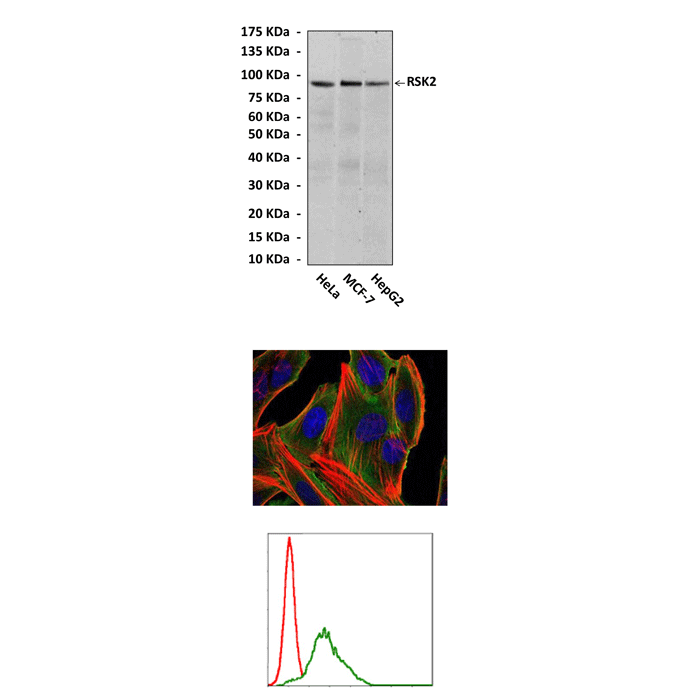Anti-RSK2: Mouse RSK2 Antibody Product
Mouse RSK2 Antibody: Mouse RSK2 Antibody
Size: 100 ul
Price: $457.00
Description
The precise mechanism of RSK activation remains elusive. The current model suggests that following mitogen stimulation, ERK phosphorylates RSK1 Thr590 (according to avian RSK1 numbering; human 573), located in the activation loop of the C-terminal kinase domain, and possibly Ser381 (turn motif; human 363) and Thr377 (human 359) in the linker region between the two kinase domains. Activation of RSK1 is absolutely dependent on ERK docking near the C terminus of RSK1. Activation of the C-terminal kinase domain leads to autophosphorylation of Ser398 (hydrophobic motif; human 380), also located in the linker region. This creates a docking site for PDK1, which then phosphorylates Ser239 (human 221) in the activation loop of the N-terminal kinase domain, allowing RSK to phosphorylate all its targets.4 Interestingly, Ser749 (human 732) is located near the ERK docking site and represents another mitogen-regulated phosphorylation site in RSK1. This residue is thought to be regulated by autophosphorylation from the N-terminal kinase domain, as it fits a RSK consensus phosphorylation sequence (K/RXXS/T). Ser749 phosphorylation regulates interaction between ERK1/2 and RSK1. Moreover, mutations that affect RSK1 kinase activity prevent ERK1/2 dissociation from RSK1 following mitogen stimulation in vivo. Analysis of different RSK isoforms revealed that RSK1 and RSK2 dissociate from ERK1/2 following mitogen stimulation but that RSK3 remains associated with active ERK1/2. ERK dissociation from RSK1 and RSK2 correlated with shorter duration of activity compared to RSK3, indicating that ERK dissociation may shorten RSK activation.5
2. Anjum, R. & Blenis, J.: Nature Rev. Mol. Cell. Biol. 9:747-58, 2008
3. Frödin, M. & Gammeltoft, S.:Mol. Cell. Endocrin. 151:65-77, 1999
4. Jensen, C.J. et al: J. Biol. Chem. 274:27168-74, 1999
5. Roux, P.P. et al: Mol. Cell. Biol. 23:4796-804, 2003
Details
| Cat.No.: | CP10433 |
| Antigen: | Raised against recombinant human RSK2 fragments expressed in E. coli. |
| Isotype: | Mouse IgG1 |
| Species & predicted species cross- reactivity ( ): | Human, Mouse, Rat |
| Applications & Suggested starting dilutions:* | WB 1:1000 IP 1:50 – 1:100 IHC n/d ICC 1:50 – 1:200 FACS 1:50 – 1:200 |
| Predicted Molecular Weight of protein: | 90 kDa |
| Specificity/Sensitivity: | Detects RSK2 proteins in various cell lysate. |
| Storage: | Store at -20°C, 4°C for frequent use. Avoid repeated freeze-thaw cycles. |
*Optimal working dilutions must be determined by end user.
